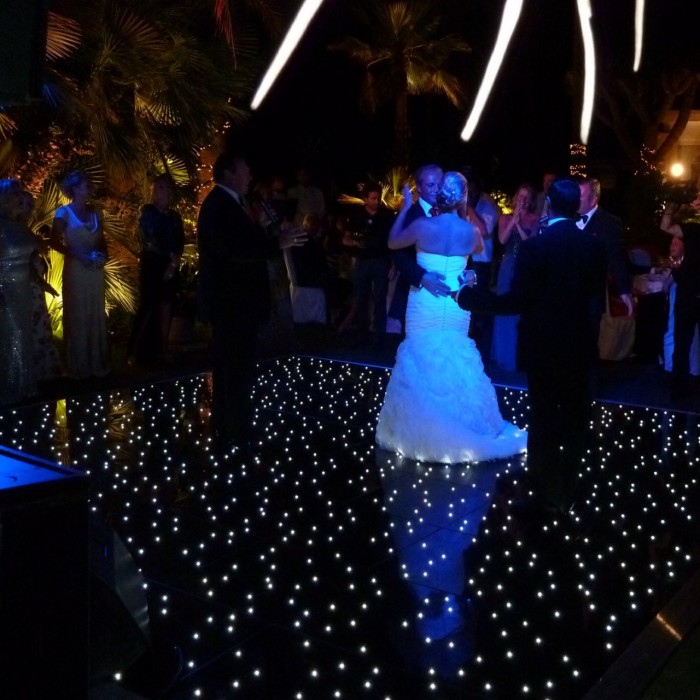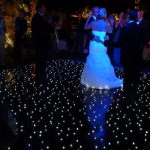Introduction
Vinyl dance floors have become the hallmark of elegance and durability in event planning. Whether it’s a wedding reception, a corporate gala, or a lively party, vinyl floors offer both style and practicality. In this guide, we will delve into the world of vinyl dance floors, exploring their benefits, types, installation, maintenance, and much more. Get ready to discover why vinyl is the ultimate choice for creating stunning dance spaces.
Table of Contents
- Why Choose a Vinyl Dance Floor?
- 1.1. Elegance Meets Durability: The Allure of Vinyl
- 1.2. Safety and Comfort on the Dance Floor
- 1.3. Versatility: From Elegance to High-Energy Events
- Types of Vinyl Dance Floors
- 2.1. Rolls vs. Interlocking Tiles: Which is Right for You?
- 2.2. Wood Grain vs. Solid Colors: Design Options Galore
- 2.3. Specialized Vinyl for Various Dance Styles
- Installation: From Rolls to Ready-to-Dance
- 3.1. DIY vs. Professional Installation: Pros and Cons
- 3.2. Preparing Your Venue for a Seamless Installation
- 3.3. Ensuring Proper Adhesion and Stability
- Maintaining Your Vinyl Dance Floor
- 4.1. Daily Cleaning Routine: Keeping the Shine Alive
- 4.2. Deep Cleaning: Reviving the Luster of Your Dance Floor
- 4.3. Repairing Minor Damage for a Flawless Finish
- Vinyl Dance Floors: Indoor vs. Outdoor Events
- 5.1. Weather Resistance: Vinyl’s Advantage Outdoors
- 5.2. Temperature Considerations for Outdoor Events
- 5.3. Adapting Vinyl Floors to Different Environments
- Customization and Branding with Vinyl
- 6.1. Personalizing Your Dance Floor for Memorable Events
- 6.2. Incorporating Logos and Designs for Corporate Events
- 6.3. The Art of Using Vinyl as a Design Element
- FAQs About Vinyl Dance Floors
- 7.1. How Do I Choose the Right Thickness of Vinyl for My Event?
- 7.2. Can Vinyl Dance Floors Be Installed Over Existing Flooring?
- 7.3. What Are the Benefits of Choosing Interlocking Vinyl Tiles?
- 7.4. Are Vinyl Dance Floors Suitable for High-Intensity Dance Styles?
- 7.5. How Can I Address Potential Slip Hazards on Vinyl Floors?
- 7.6. Can I Use Vinyl Dance Floors for Both Indoor and Outdoor Events?
Why Choose a Vinyl Dance Floor?
1.1. Elegance Meets Durability: The Allure of Vinyl
Vinyl dance floors offer a perfect blend of sophistication and resilience. With a surface that emulates the look of wood or tile, they add a touch of elegance to any event. Simultaneously, their durable construction ensures they can withstand the rigors of dancing shoes and high-heeled footsteps.
1.2. Safety and Comfort on the Dance Floor
Safety is paramount on the dance floor, and vinyl provides a non-slip surface that keeps dancers on their feet. Additionally, the slight cushioning of vinyl adds comfort, reducing the strain on dancers’ joints, especially during prolonged periods of dancing.
1.3. Versatility: From Elegance to High-Energy Events
Vinyl dance floors are remarkably versatile. They can seamlessly transition from hosting a sophisticated waltz at a wedding reception to accommodating the energetic moves of a high-octane dance party. Their adaptability makes them an ideal choice for a wide range of events and dance styles.
Types of Vinyl Dance Floors
2.1. Rolls vs. Interlocking Tiles: Which is Right for You?
When it comes to vinyl dance floors, you have two main options: rolls and interlocking tiles. Rolls offer a seamless look, ideal for larger event spaces. Interlocking tiles, on the other hand, provide versatility and ease of installation, making them suitable for events of various sizes and layouts.
2.2. Wood Grain vs. Solid Colors: Design Options Galore
Vinyl dance floors come in a range of designs, with the most popular being wood grain and solid colors. Wood grain vinyl offers a classic, elegant aesthetic, while solid colors provide a contemporary and vibrant look. Choosing the right design will depend on the overall theme and ambiance you want to create for your event.
2.3. Specialized Vinyl for Various Dance Styles
Different dance styles require specific flooring characteristics. For example, ballet dancers may benefit from a slightly cushioned surface, while hip-hop dancers may require a more resilient, non-slip surface. Specialized vinyl options cater to these specific needs, ensuring that dancers can perform at their best.
Installation: From Rolls to Ready-to-Dance
3.1. DIY vs. Professional Installation: Pros and Cons
Deciding between DIY installation and professional installation depends on factors like the size of the floor, the complexity of the setup, and your level of expertise. While DIY can save costs, professional installation ensures a flawless finish and guarantees safety on the dance floor.
3.2. Preparing Your Venue for a Seamless Installation
Prior to installation, it’s crucial to prepare the venue properly. This includes ensuring a clean, level surface and addressing any potential issues that could affect the stability or appearance of the dance floor. Adequate preparation sets the stage for a successful installation.
3.3. Ensuring Proper Adhesion and Stability
Proper adhesion is essential for the longevity of your vinyl dance floor. Whether using adhesives for rolls or interlocking mechanisms for tiles, ensuring a secure connection is crucial. This step guarantees that the floor remains stable, even under the most dynamic dance moves.
Maintaining Your Vinyl Dance Floor
4.1. Daily Cleaning Routine: Keeping the Shine Alive
A regular cleaning routine is key to preserving the beauty of your vinyl dance floor. This involves sweeping or vacuuming to remove debris, followed by a gentle mopping with a vinyl-approved cleaner. Avoid harsh chemicals or abrasive materials, as they can damage the surface.
4.2. Deep Cleaning: Reviving the Luster of Your Dance Floor
Over time, dirt and grime may accumulate, dulling the shine of your vinyl floor. Periodic deep cleaning is essential to restore its luster. This involves using specialized vinyl floor cleaners and, if needed, a floor buffer with a soft pad for a thorough clean.
4.3. Repairing Minor Damage for a Flawless Finish
In the event of minor damage, such as scratches or scuffs, it’s important to address them promptly. Using vinyl repair kits, you can easily fix small imperfections to maintain the seamless appearance of your dance floor.
Vinyl Dance Floors: Indoor vs. Outdoor Events
5.1. Weather Resistance: Vinyl’s Advantage Outdoors
One of the significant advantages of vinyl dance floors is their weather resistance, making them suitable for outdoor events. They can withstand exposure to sunlight, rain, and varying temperatures, ensuring your event proceeds smoothly regardless of the weather.
5.2. Temperature Considerations for Outdoor Events
While vinyl is highly adaptable, extreme temperatures can affect its performance. In very hot conditions, vinyl may become more pliable, while in very cold conditions, it may become slightly more rigid. Understanding these characteristics helps in proper planning for outdoor events.
5.3. Adapting Vinyl Floors to Different Environments
Vinyl dance floors can be adapted to various environments, including ballrooms, outdoor venues, and even temporary event spaces. Understanding the unique requirements of each setting allows for effective planning and seamless integration of the dance floor.
Customization and Branding with Vinyl
6.1. Personalizing Your Dance Floor for Memorable Events
Adding a personal touch to your event is made easy with vinyl dance floors. They can be customized with monograms, event logos, or specific patterns to create a unique and memorable experience for your guests.
6.2. Incorporating Logos and Designs for Corporate Events
For corporate events, vinyl dance floors offer an opportunity to showcase brand logos and designs. This not only reinforces brand identity but also creates a visually impressive focal point for the event.
6.3. The Art of Using Vinyl as a Design Element
Vinyl dance floors can serve as more than just a functional surface; they can be an integral design element. By choosing the right colors, patterns, and customization options, you can elevate the overall aesthetic of your event space.
FAQs About Vinyl Dance Floors
General Questions are always about “How Much is it to Hire a Dance Floor?” The answer is dependant on event location, type of dance floor, size of dance floor and if any acccessories included. Other FAQ below and within website.
7.1. How Do I Choose the Right Thickness of Vinyl for My Event?
- The thickness of vinyl dance floors can vary. For high-traffic events or areas with heavy equipment, opt for thicker vinyl (around 2mm). For standard events, a thickness of 1.5mm is generally sufficient.
7.2. Can Vinyl Dance Floors Be Installed Over Existing Flooring?
- In many cases, yes. However, it’s important to ensure that the existing flooring is clean, level, and in good condition. Additionally, certain types of vinyl may require specific preparations for installation.
7.3. What Are the Benefits of Choosing Interlocking Vinyl Tiles?
- Interlocking vinyl tiles offer versatility and ease of installation. They can be assembled without the need for adhesives, making them a popular choice for temporary or multi-use spaces. They also allow for easy replacement of damaged tiles.
7.4. Are Vinyl Dance Floors Suitable for High-Intensity Dance Styles?
- Yes, vinyl dance floors are suitable for high-intensity dance styles. They offer a balanced level of slip resistance and smoothness, allowing dancers to move freely while still providing a level of comfort and safety.
7.5. How Can I Address Potential Slip Hazards on Vinyl Floors?
- To minimize slip hazards, consider using a non-slip dance floor finish or adding temporary grip-enhancing products. Additionally, ensure that the floor is kept clean and free from any spills or debris that could contribute to slipping.
7.6. Can I Use Vinyl Dance Floors for Both Indoor and Outdoor Events?
- Yes, many vinyl dance floors are designed to be versatile and can be used for both indoor and outdoor events. However, it’s important to verify with the manufacturer or rental company to ensure that the specific floor you choose is suitable for outdoor use.
Conclusion: Elevating Events with Vinyl Dance Floors
Vinyl dance floors are not just surfaces for dancing; they are the foundation for unforgettable events. Their blend of elegance, durability, and versatility makes them a top choice for event planners and hosts alike. Whether indoors or outdoors, for weddings or corporate galas, vinyl dance floors provide a canvas for creating magical moments that will be cherished for years to come.
By understanding the various types, installation techniques, and maintenance practices, you can make the most of your vinyl dance floor and ensure it remains a stunning focal point of your events. So, step onto the floor, let the music play, and watch as your event transforms into an extraordinary experience that leaves a lasting impression on all who attend.






